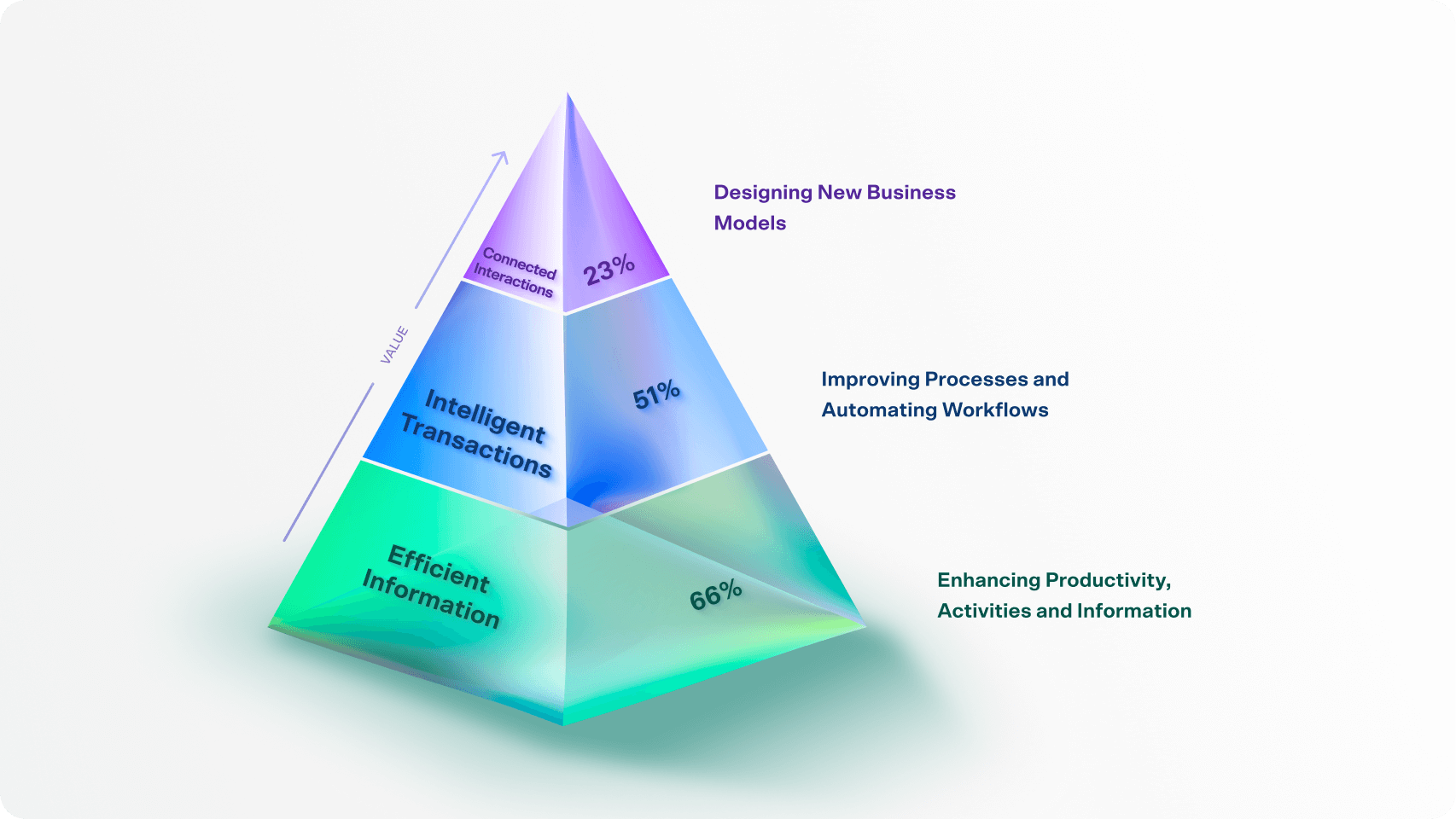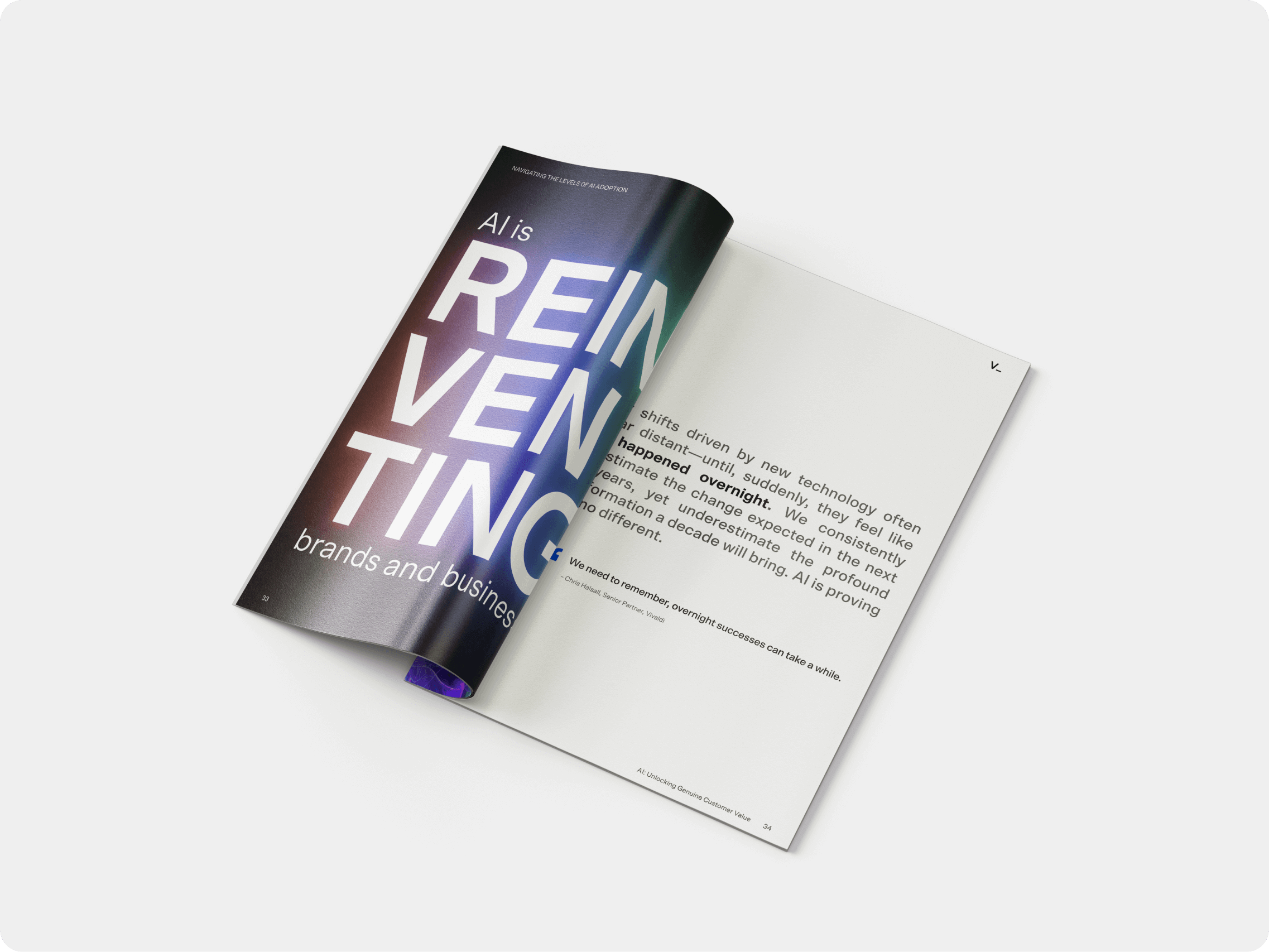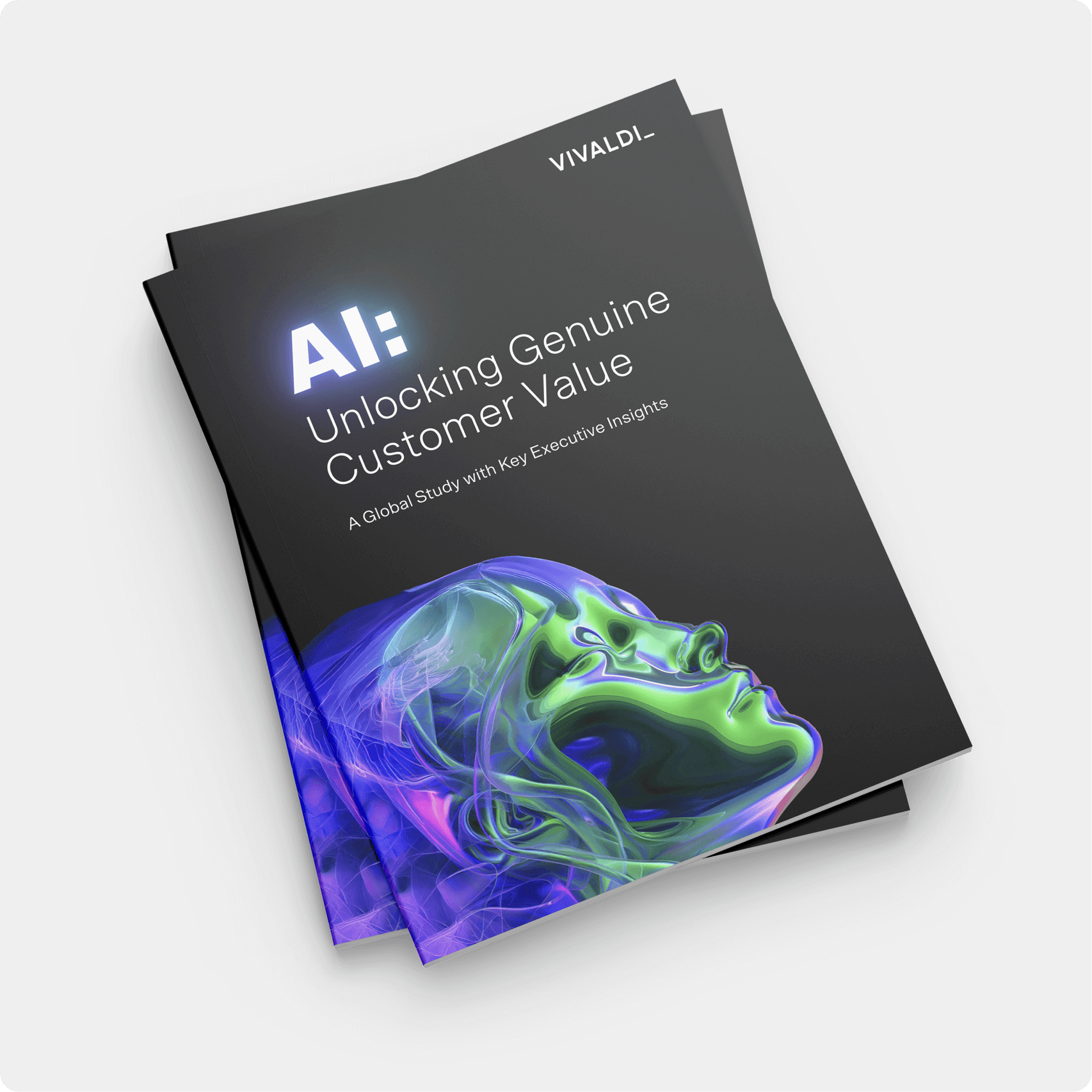Last Wednesday, we gathered in New York City for the launch of Vivaldi Group’s latest report: AI: Unlocking Genuine Customer Value. This wasn’t just another event—it was an opportunity to challenge the status quo, explore the state of AI deployment in business, and reimagine what AI can achieve in a world defined by constant disruption and reinvention.
At the heart of the discussions, business leaders, innovators, and strategists tackled one defining question: How can AI deliver value for companies that lasts? They explored AI capabilities in enhancing software platforms and driving sustainability initiatives, emphasizing the potential of AI to optimize operations and compliance with sustainability regulations. AI innovation was also highlighted for its transformative potential across various industries, reshaping sectors like healthcare, finance, and manufacturing through automation and data analysis.
We extend our gratitude to the remarkable leaders who made this event unforgettable. From CEOs to innovation and brand pioneers, their insights enriched the dialogue and reinforced a vital truth: a new era for brands has arrived, and only the bold leaders who embrace it will endure.
- Sabrina Romviel speaking at Vivaldi’s 2025 AI Report launch event
- Audience at Vivaldi’s AI Report Launch Event
- Audience at Vivaldi’s AI event
- Audience at Vivaldi’s AI Report Launch Event
The Problem: Misdirected Focus
While 75% of companies claim to use AI, only 10% report meaningful results. Why? Most businesses remain stuck in the lower tiers of the AI Adoption Pyramid—fixated on task efficiencies and process optimization rather than integrating AI into their core business strategy to enhance overall business performance and meet customers’ emergent needs.
The AI Adoption Pyramid, a central framework in our report, reveals the stark reality: 66% of companies adopting AI are confined to the base level, focusing solely on productivity gains.
Integrating AI into corporate strategy is crucial for achieving sustainability goals. Businesses need to be strategic in deploying AI to optimize its benefits, particularly in emissions-intensive sectors.
But what about those at the top? The 10% of leaders deploying AI to design new business models and redefine core interactions with customers are rewriting the rules of competition. These leaders have embraced AI’s Superpower of Duality, a state of continuous reinvention that creates lasting value for both customers and businesses simultaneously.

Why Focus Matters: Elevating AI Beyond Efficiency
The AI Adoption Pyramid underscores a vital truth: not all AI initiatives are created equal. Where you focus matters. Leaders who confine their AI strategy to productivity gains risk blending into a sea of sameness, while those who aim for the top of the pyramid are redefining competition by establishing clear key performance indicators to assess and refine their AI initiatives.
Businesses that deliver transformative value don’t just optimize processes—they rethink how they connect with customers. They focus on:
- Core Interactions: The critical connections in the customer activity cycle where businesses can meet emergent needs and deliver the most value.
- Moments of Value: Key points in the customer activity cycle where AI can anticipate and address friction or complexity, shaping the system around the customer’s future needs.
- Ecosystems of Interaction: Connecting workflows and stakeholders to eliminate disjointed experiences and create value for all participants.
Strategic investments in AI can unlock new opportunities and drive exponential growth, significantly increasing revenue potential across various business functions and markets.
Where You Focus Matters: Elevating AI to Reinvent, Not Just Improve
The AI Adoption Pyramid teaches us that where you focus matters. AI systems significantly enhance efficiency and decision-making, making them foundational to productivity. However, the highest levels—intelligent transactions and connected interactions—are where real transformation occurs. Leaders operating at these levels are not just improving; they’re reinventing.
Partnering with leading tech companies is crucial in driving AI integration and innovation, reshaping organizational success in the rapidly evolving AI landscape.
1. Broaden and Deepen Customer Experience
AI allows businesses to map the full activity cycle of their customers, identifying the most pivotal moments to create value and enhance customer experience through improved brand strategy and customer interactions. This isn’t just about addressing existing needs—it’s about anticipating and acting on emerging ones.
Natural language processing plays a crucial role in improving customer interactions and personalization. By analyzing customer data and understanding preferences, businesses can deliver tailored recommendations and utilize AI-powered chatbots to provide instant support, significantly advancing customer service capabilities.
Key Question: Are you designing your AI strategy to identify and act on the moments of value that matter most to your customers?
2. Drive AI Innovation by Redefining Products and Services
AI innovation enables leaders to reimagine products and services, creating solutions that evolve alongside the needs of customers. This turns customer insights into innovations that not only solve current challenges but also prepare for what’s next. Machine learning plays a crucial role in this process by enhancing efficiency and decision-making, analyzing large datasets to identify patterns and make informed choices.
Key Question: How are you using AI to redefine offerings in ways that adapt to customers’ emergent needs and aspirations?
3. Achieve Operational Excellence Beyond Efficiency
AI’s potential lies in creating systems that deliver scalability and consistency without sacrificing the flexibility to innovate. Companies like John Deere demonstrate how embedding AI transforms operations into competitive advantages, particularly in supply chain management, driving significant improvements in efficiency and cost savings.
AI capabilities play a crucial role in optimizing operations and ensuring compliance with sustainability regulations. By integrating AI, businesses can collect and analyze data that supports environmental goals and operational efficiency.
Key Question: Is your AI strategy designed to consistently deliver quality and adaptability in response to market and customer changes?
4. Strengthen Your Strong Brand Identity to Amplify All Other Drivers
AI, when aligned with your brand’s vision and a well-crafted brand message, becomes a multiplier of trust and loyalty. It accelerates the impact of all other drivers by delivering smarter, more relevant solutions that enhance your brand’s role in customers’ lives.
A comprehensive brand strategy is essential in defining brand identity and establishing trust among customers. It ensures that your brand remains competitive and resonates with your target audience.
Key Question: How is AI amplifying your brand’s ability to meet customers’ evolving needs and forge deeper connections?
Continuously refining your brand strategy is crucial for developing a strong brand identity that differentiates you from competitors. Regular assessment of audience responses and competitor positioning ensures that your branding efforts are effective and impactful.

The Vivaldi Group AI Playbook: A Roadmap for Bold Business Leaders
Maximizing the full potential of AI requires a systematic, strategic approach firmly anchored in value creation and integrated into the corporate strategy to achieve sustainability goals. Businesses must anticipate emerging needs, build trust, and deepen customer loyalty. The Vivaldi Group AI Playbook offers a clear roadmap:
Aligning AI initiatives with organizational goals is crucial for enhancing overall business performance. By integrating AI into the core business strategy, companies can significantly boost productivity and revenue.
1. Map Demand
Identify customer activity cycles and pinpoint moments of value by establishing clear key performance indicators to monitor effectiveness and make necessary adjustments. Remove friction at critical points to meet emerging needs and master core interactions—not just participate in them. The journey begins with understanding today’s moments of value while anticipating tomorrow’s demands.
Enhancing customer experience is crucial for refining brand strategy and improving customer interactions. Continuously refine efforts based on audience feedback and market analysis to ensure that strategies resonate with customers and improve overall satisfaction and loyalty.
2. Define Strategic Value Drivers
Assess your organization’s strengths and align AI opportunities to amplify competitive advantages. Use AI capabilities to create autonomy, reduce barriers, and enable smarter workflows that meet evolving customer demands.
Machine learning plays a crucial role in enhancing efficiency and decision-making. By integrating machine learning algorithms, businesses can analyze large datasets to identify patterns and make informed choices, transforming operational processes and customer interactions.
3. Prioritize Opportunities
Focus on initiatives that balance bold bets with quick wins, identifying dual-value opportunities where customer and business benefits intersect, leading to exponential growth by unlocking new opportunities and enhancing competitiveness. Measure success with clear metrics tied to long-term growth.
Partnering with leading tech companies can drive AI integration and innovation, reshaping organizational success in the rapidly evolving AI landscape.
4. Plan and Deploy in Waves
Launch targeted AI programs in waves, iterating and scaling as you learn. AI systems can significantly enhance efficiency and decision-making across various industries, including healthcare, finance, and manufacturing. Embed AI into customer routines and systems that evolve with changing needs and market dynamics.
Natural language processing is crucial for improving customer interactions and personalization. It enables businesses to analyze customer data, understand preferences, and deliver tailored recommendations, ultimately enhancing customer satisfaction and loyalty.
As Anne Olderog, Senior Partner at Vivaldi, said, “Hope is not a strategy. Leaders who embrace AI strategically—those who build around core interactions and emerging customer demand—are the ones who will redefine industries.”

Building the Future Together
2025 is not just another year; it marks the beginning of an era of constant reinvention. The bold leaders who embrace AI as a transformative force with a successful brand strategy will make a strong first impression and differentiate from competitors, defining the future of their industries—not just adapt to it.
Continuously analyzing and refining your brand strategy is essential to develop a strong brand identity that resonates with your target audience and stands out from competitors.
This is your moment. Download the report, explore the Playbook, and join the movement. Together, let’s turn AI’s potential into a strategic advantage that creates genuine value for your business, your customers, and the world.
- Attendees at Vivaldi’s AI Launch Event networking after the presentation
- Attendees at Vivaldi’s AI Launch Event networking after the presentation
- Anne, Lal and Sabrina, three of the speakers at the event
- Fellow CEOs gathered with Erich Joachimsthaler at Vivaldi’s AI Launch Event
- Post-event networking
- Attendees at Vivaldi’s Launch Event










